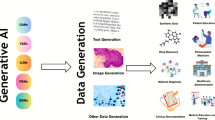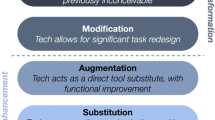Abstract
Standards have played an important but often unrecognized role in the development of modern organizations. This role is accentuated by today’s growth of large business and government infrastructures, in the turbulent processes of globalization. In this paper, we investigate the relationships – and tensions – between standardization strategies and service innovation in the health-care sector. Our empirical material is seven longitudinal case studies in the Norwegian health-care sector, collected and analysed over a period of 20 years. We identify three generic standardization strategies; anticipatory standardization, integrated solutions and flexible generification. We argue that the first two strategies do not support service innovation while the strategy of flexible generification does so. We consider our results important for the evolution of the future ICT-enabled service economy.

Similar content being viewed by others
References
Abbate J (1999) Inventing the Internet. MIT Press, Cambridge, MA.
Avgerou C (2002) New socio-technical perspectives of is innovation in organizations. In ICT Innovation: Economic and Organizational Perspectives (Avgerou C and LaRovere RL, Eds), Edward Elgar, Cheltenham.
Barry A (2001) Political Machines: Governing a Technological Society. The Athlone Press, London.
Blind K (2013) The impact of standardization and standards on innovation. Manchester Institute of Innovation Research. [WWW document] http://www.nesta.org.uk/sites/default/files/the_impact_of_standardization_and_standards_on_innovation.pdf, (accessed 13 February 2015).
Botzem S and Dobusch L (2012) Standardization cycles: a process perspective on the formation and diffusion of transnational standards. Organization Studies 33 (5–6), 737–762.
Braa J, Hanseth O, Mohammed W, Heywood A and Shaw V (2007) Developing health information systems in developing countries. The flexible standards strategy. MIS Quarterly 31 (2), 381–402.
Brunsson N and Jacobsson B (2002) The contemporary expansion of standardization. In A World of Standards (Brunsson N, Jacobsson B and Associates, Eds), Oxford University Press, New York.
Brunsson N, Rasche A and Seidl D (2012) The dynamics of standardization: three perspectives on standards in organization studies. Organization Studies 33 (5–6), 613–632.
Busquets J (2010) Orchestrating smart business network dynamics for innovation. European Journal of Information Systems 19 (4), 481–493.
Christensen T and Grimsmo A (2005) Development of functional requirements for electronic health communication: preliminary results from the ELIN project. Informatics in Primary Care 13 (3), 203–208.
Ciborra C (1992) From thinking to tinkering: the grassroots of strategic information systems. The Information Society 8 (4), 297–309.
den Hertog P (2000) Knowledge-intensive business services as co-producers of innovation. International Journal of Innovation Management 4 (4), 491–528.
de Vries HJ (1999) Standardization: A Business Approach to the Role of National Standardization Organizations. Kluwer Academic Publishers, Dordrecht.
Dunphy SM, Herbig PR and Howes ME (1996) The innovation funnel. Technological Forecasting and Social Change 53 (3), 279–292.
Eaton B, Elaluf-Calderwood S, Sørensen C and Yoo Y (2011) Dynamic structures of control and generativity in digital ecosystem service innovation: the cases of the Apple and Google mobile app stores. LSE Working Paper, http://is2.lse.ac.uk/wp/pdf/wp183.pdf.
Egyedi TM and Blind K (2008) The Dynamics of Standards. Edward Elgar Publishing, Chelterham, UK.
European Commission (2011) The transformative power of service innovation. [WWW document] http://ec.europa.eu/enterprise/initiatives/esic/materials/expert_panel_report.pdf, (accessed 13 February 2015).
Fitzsimmons JA and Fitzsimmons MJ (2000) New Service Development: Creating Memorable Experiences. Sage Publications, Thousands Oaks.
Fomin V, Keil T and Lyytinen K (2003) Theorizing about standardization: integrating fragments of process theory in light of telecommunication standardization wars, Case Western Reserve University, USA. Sprouts: Working Papers on Information Systems, 3(10), http://sprouts.aisnet.org/3-10.
Fürst (2014) Fürst forum. [WWW document] http://www.furst.no/for-legekontoret/furst-forum/ (accessed 22 April).
Hanseth O (2002) From systems and tools to networks and infrastructures. Toward a theory of ICT solutions and its design methodology implications. [WWW document] http://heim.ifi.uio.no/~oleha/Publications/ib_ISR_3rd_resubm2.html (accessed April 2014).
Hanseth O and Aanestad M (2003) Bootstrapping networks, communities and infrastructures – on the evolution of ICT solutions in healthcare. Methods of Information in Medicine 42 (4), 385–391.
Hanseth O and Lyytinen K (2010) Theorizing about the design of information infrastructures: design Kernel theories and principles. Journal of Information Technology 25 (1), 1–19.
Hanseth O and Monteiro E (1997) Inscribing behaviour in information infrastructure standards. Accounting, Management and Information Systems 7 (4), 183–211.
Hanseth O, Monteiro E and Hatling M (1996) Developing information infrastructure: the tension between standardization and flexibility. Science, Technology and Human Values 21 (4), 407–126.
Henfridsson O and Bygstad B (2013) The generative mechanisms of digital infrastructure evolution. MIS Quarterly 37 (3), 907–931.
Hitt MA, Beamish PW, Jackson SE and Mathieu JE (2007) Building theoretical and empirical bridges across levels: multilevel research in management. Academy of Management Journal 50 (6), 1385–1399.
HOD (1996) Mer helse for hver BIT. [WWW document] http://www.regjeringen.no/nb/dep/hod/dok/veiledninger_og_brosjyrer/1996/merhelse-for-hver-bit.html?id=87401, accessed 13 February 2015.
HOD (2008) Samspill 2.0 [WWW document] http://www.innomed.no/media/filer/14_Helsedirektoratet_samspill_2.0_og_sammendrag.pdf, accessed 13 February 2015.
Hovenga EJS, Kidd MR, Garde S and Hullin Lucay Cossio C (2010) Health Informatics: An Overview. IOS Press, London.
ITU (2012) E-health standards and interoperability. ITU-T Technology Watch Report April 2012. [WWW document] http://www.itu.int/dms_pub/itu-t/oth/23/01/T23010000170001PDFE.pdf (accessed 7 April 2014).
Johannessen LK and Ellingsen G (2009) Integration and generification – Agile software development in the healthcare market. Computer Supported Cooperative Work 18 (5–6), 607–634.
Langley A (1999) Strategies for theorizing from process data. Academy of Management Review 24 (4), 691–710.
Lessig L (2001) The law of the horse: what cyberlaw might teach. Harvard Law Review 113, 501–546.
Lusch RF and Nambisan S (2014) Service innovation: a service-dominant logic perspective. MIS Quarterly 39 (1), 155–176.
Lyytinen K and King J (2006) Standard making: a critical research frontier for information systems research. MIS Quarterly 30 (Special Issue), 405–411.
Miles MB and Huberman AM (1994) Qualitative Data Analysis. Sage Publications, Thousand Oaks.
Mintzberg H (1978) Patterns in strategy formation. Management Science 24 (9), 934–948.
MOH (2012) Én innbygger – én journal. Digitale tjenester i helse- og omsorgssektoren. Meld. St. 9 (2012–2013). Melding til Stortinget. Det Kongelige Helse- og Omsorgsdepartement, [WWW document] https://www.regjeringen.no/nb/aktuelt/en-innbygger---en-journal/id708834/, (accessed 13 February 2015).
Nardelli G (2012) The complex relationship between ICT and innovation in services: a literature review. In SCIS 2012 (Keller C, Wiberg M, Ågerfalk PJ and Eriksson Lundström JSZ, Eds), LNBIP 124 pp 1–24, Springer-Verlag, Berlin Heidelberg.
Nickerson JV and zur Muehlen M (2006) The ecology of standards processes: insights from intenret standard making. MISQ 30 (Special Issue on Standardization), 467–488.
Northrop L et al (2006) Ultra-Large-Scale Systems: The Software Challenge of the Future. Carnegie Mellon Software Engineering Institute, [WWW document] http://www.sei.cmu.edu/library/assets/uls_book20062.pdf, (accessed 13 February 2015).
Pedersen ML (1996) Standardisering og systemutvikling. To Case fra Helsesektoren. Hovedoppgave i informatikk ved NTNU, Trondheim, (in Norwegian).
Pettigrew AM (1985) Contextualist research and the study of organizational change processes. In Research Methods in Information Systems (Mumford E, Hirschheim R, Fitgerald G and Wood-Harper AT, Eds) pp 53–78, North-Holland, Amsterdam.
Pollock N, Williams R and D’adderio L (2007) Global software and its provenance: generification work in the production of organizational software packages. Social Studies of Science 37 (2), 254–280.
RFC (1996) The internet standards process – revision 3. RFC 2026, IAB and IESG. [WWW document] https://www.rfc-editor.org/rfc/rfc2026.txt (accessed 7 October 2013).
Riksrevisjonen (2014) Riksrevisjonens undersøkelse om elektronisk meldingsutveksling i helse- og omsorgssektoren. Dokument 3:6 (2013–2014). [WWW document] http://www.riksrevisjonen.no/Rapporter/Documents/2013-2014/RiksrevisjonensUnders%C3%B8kelseOmElektroniskMeldingsutveksling.pdf (accessed 24 April 2014).
Romer PM (1990) Endogenous technological change. The Journal of Political Economy 98 (5), 71–102.
Saltzer JH, Reed DP and Clark DD (1984) End-to-end arguments in system design. ACM Transactions on Computer Systems 2 (4), 277–288.
Sauer C and Willcocks LP (2007) Unreasonable expectations – NHS IT, Greek choruses and the games institutions play around mega-programmes. Journal of Information Technology. 22 (3), 195–201.
Schmidt SK and Werle R (1998) Coordinating Technology: Studies in the International Standardization of Telecommunications. The MIT Press, Cambridge, MA.
Schumpeter JS (2012) Capitalism, Socialism and Democracy. Routledge, London, UK.
Star SL and Ruhleder K (1996) Steps toward an ecology of infrastructure: design and access for large information spaces. Information Systems Research 7 (1), 111–134.
Tidd J and Bessant J (2009) Managing Innovation: Integrating Technological, Market and Organizational Change. John Wiley & Sons, London.
Tidd J and Hull FM (2003) Service Innovation. Organizational Responses to Technological Opportunities & Market Imperatives. Imperial College Press, London.
Updegrove A (2007) ICT standard setting today: a system under stress. First Monday, 12 (6). [WWW document] http://firstmonday.org/issues/issue12_6/updegrove/index.html.
van den Ende J, van de Kaa G, den Uijl S and de Vries HJ (2012) The paradox of standard flexibility: the effects of co-evolution between standard and interorganizational network. Organization Studies 33 (5–6), 705–736.
Wakke P, Blind K and de Vries HJ (2012) The relationship between innovation in services and standardization: empirical evidence of service providers’ involvement in standardization. [WWW document] http://papers.ssrn.com/sol3/papers.cfm?abstract_id=2045484, accessed 13 February 2015.
Author information
Authors and Affiliations
Appendix
Rights and permissions
About this article
Cite this article
Hanseth, O., Bygstad, B. Flexible generification: ICT standardization strategies and service innovation in health care. Eur J Inf Syst 24, 645–663 (2015). https://doi.org/10.1057/ejis.2015.1
Received:
Revised:
Accepted:
Published:
Issue Date:
DOI: https://doi.org/10.1057/ejis.2015.1





